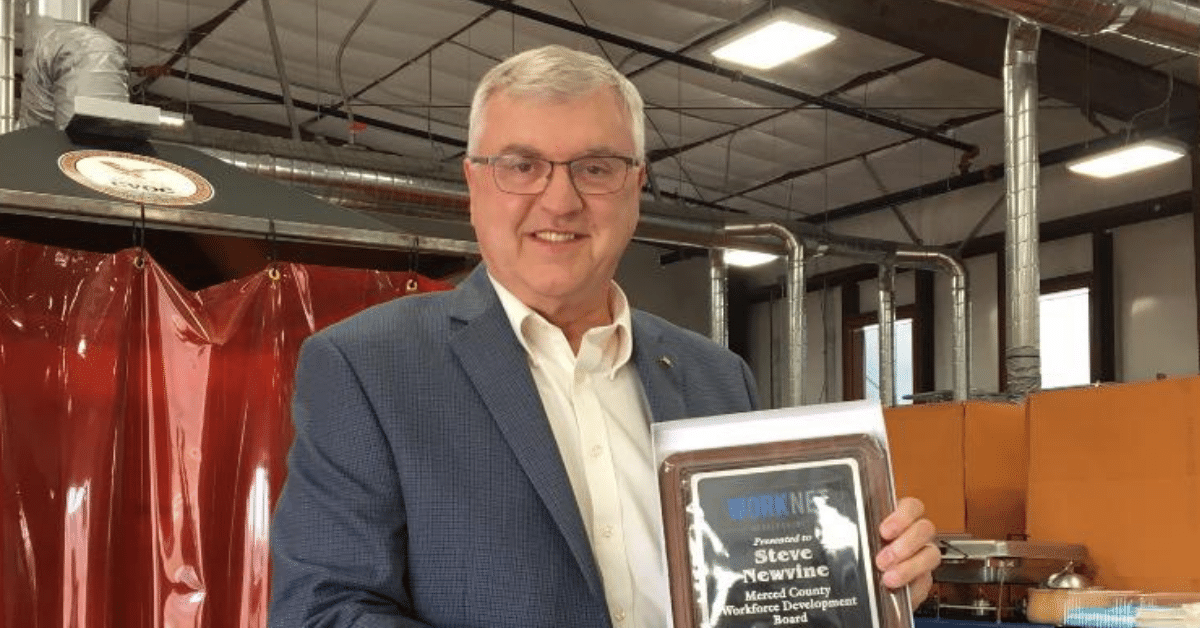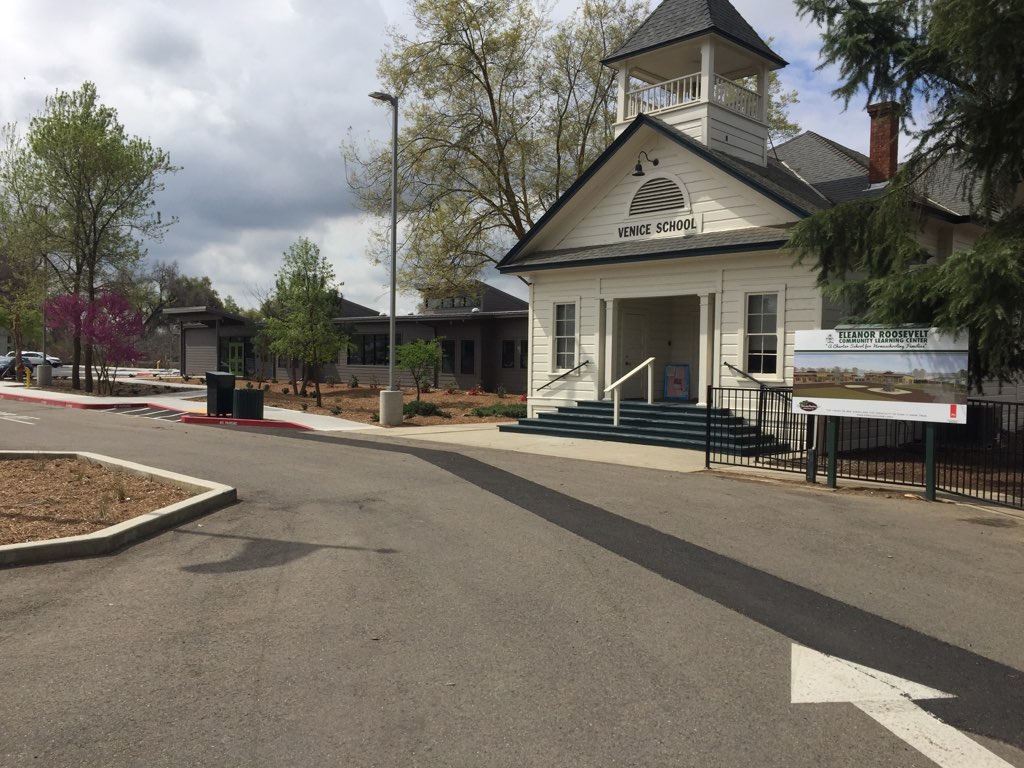
Two-room Schoolhouse is Part of a Bigger Picture for Students
How the Venice school in Tulare County Helps Home School Families
The former Venice School building is part of the Eleanor Roosevelt Community Learning Center. Photo- Steve Newvine
It’s an ordinary old time school house. It looks like something you might have seen on the television series Little House on the Prairie or When Calls the Heart.
Except, this school house is real. Not only that, this school house is still being used to educate students.
In Tulare County, a two-room school house continues to serve students. The tale of this school house tells a much bigger story about education in the Central Valley.
The Venice school along with other buildings that make up the Eleanor Roosevelt Community Learning Center. Photo- Steve Newvine
Sometimes while driving around the back roads of California, one can come across a building that looks as if it was an old school house from many years ago.
Some of these buildings have been modified for other uses. Others have been abandoned.
The Venice School’s history goes back to 1898 when it opened as a rural school.
Farm families needed a school for their children. The Venice School, both rooms, filled that need.
The family that owned the building and land deeded it to the local district with the express condition that it remains a school.
According to a stone monument on the property placed by the historical organization E Clampus Vitus, the building reverted to the owners when the school closed in 1957.
It reopened as a private school in 1996, and eventually was repurposed as a library for the Eleanor Roosevelt Learning Center (ERLC).
The former Venice School is now a library that supports the enrichment activities for the Eleanor Roosevelt Learning Center. Photo- Steve Newvine
The Learning Center is a complex of buildings on a country road east of the City of Visalia.
“We’re very proud of the two-room school house,” Learning Center Superintendent & Principal Daniel Huecker says. “And we’re extremely proud of the students, parents, and enrichment specialists of the Eleanor Roosevelt Learning Center.”
In the early part of this century, a handful of homeschooled families wanted a centralized resource to provide enrichment opportunities for their children.
In 2001, they formed the first charter school in Tulare County.
A few years later, a private school housed in the Willow building closed. The Learning Center took over the site east of the City of Visalia and has been using it and improving it ever since.
One of the buildings on that site was known as the old Venice School. The two-room schoolhouse was acquired by the Learning Center many years ago with a stipulation that it be used for educational purposes.
This new staff building at the Eleanor Roosevelt Learning Center opened in 2019. Photo- Steve Newvine
Over the years, portable classrooms have been added to the site.
Earlier this year, a permanent staff building was added along with a parent/classroom building as well as an outdoor assembly pavilion.
Superintendent Huecker emphasizes how important it is for homeschooled students to have a base to connect among one another.
“It’s important for the kids to get together,” he says. “It’s also important for parents to know they have resources available to assist in homeschooling their children.”
The Eleanor Roosevelt Community Learning Center serves two-hundred, seventy-five students from kindergarten through the twelfth grade.
All are homeschooled, and all are part of this unique educational resource.
Enrichment facilities including an outdoor assembly area, playground, and basketball court have been added to the Eleanor Roosevelt Learning Center. Photo- Steve Newvine
Credentialed educators meet with parents regularly to assist in helping students succeed.
Center staff and parents work together on the creation of personal education plans.
The team at the Center also helps with the selection from over sixty enrichment programs available to students. Enrichment programs available to students include: robotics, woodshop, and drama.
The logo for Learning Center uses the school house image. Photo: ERCLC.
The two-room school house is so important a symbol of aspirational leadership in education, the Learning Center uses it as a logo.
The Center staff is a resource for homeschool families four days a week; two days for elementary support and two days for secondary support.
Daniel says the Center’s role as a meeting place for parents is a key component in their children’s success.
“They have an opportunity to visit with other parents, compare ideas, and get support from a wide variety of educators,” he adds.
The bell on top of the Willow School. Photo: Steve Newvine
The two-room school house is so important a symbol of aspirational leadership in education, the Learning Center uses it as a logo.
Many decades ago, the Venice School opened to provide education for students living in rural areas.
The delivery of education has changed over the years, but with the repurposing of the Venice School as a library for the Eleanor Roosevelt Community Learning Center, there is a sense of turning back to the successful basics.
So that ordinary looking two-room school house may always remind you of a classic television show.
But in Tulare County, it represents a bold effort to support the efforts of families that choose to home school their children.
Steve Newvine lives in Merced.
You can read about some of the places he has traveled in the golden state in his book California Back Roads, available at Lulu.com
For more about the Eleanor Roosevelt Community Learning Center, go to ERCLC.org
Celebrating Central Valley Music Pioneers
Bakersfield Music Hall of Fame Honors Performers
The Bakersfield Music Hall of Fame. Photo-Steve Newvine
For Kim McAbee-Carter, the founding of a Hall-of-Fame to honor musicians from Bakersfield made a lot of sense.
As a singer, she performed regularly at the Crystal Palace in Bakersfield singing alongside country music legend Buck Owens.
She sang with him right up to the last night he performed in his adopted hometown.
Buck died in 2006, and while the music went on over the years for Kim, a deep-seated idea to honor Bakersfield music performers continued to grow.
That idea has led to the creation, along with her husband, of the Bakersfield Music Hall of Fame.
The Hall of Fame honors the people who made Bakersfield proud.
It also contains items you might see in a music museum. And it is a venue for the performing arts.
“The Hall of Fame was started to promote the rich heritage of the not just country music, but all music,” Kim says. “We pay tribute to the local people who played a role in creating that music.”
Inside the Bakersfield Music Hall of Fame. Photo-Steve Newvine
While this Hall of Fame is a home for all genres of music, there’s no doubt the initial focus is on country.
To be specific: The Bakersfield Sound.
The Bakersfield Sound was a title given to the music pioneered by Buck Owens and the Buckaroos, his lead guitarist Don Rich, and the legendary Merle Haggard.
The Bakersfield Sound is described in my book 9 from 99, Experiences from California’s Central Valley as “Country, with an emphasis on electric guitars that sound as though the treble has been turned way up.” There are other definitions, but I’ll stand by mine.
Photographs like this one of music pioneers are on display at the Bakersfield Music Hall of Fame
The Bakersfield Music Hall of Fame is more than a tribute to the Bakersfield Sound.
In the inaugural class of seventeen Central Valley music artists, country accounted for the first five honored in 2017.
The honorees range from country, nu metal, opera, and beyond. To give each honoree an appropriate induction, the inaugural class was divided into three smaller classes.
The first five are: Buck Owens, Merle Haggard, Bonnie Owens, steel guitarist Billy Mize, and singer songwriter of truck driving songs Red Simpson.
“The inaugural Class was broken into three sections so that we could spend time honoring each individual,” Kim says.
Life-sized drawings of some of the honorees at the Bakersfield Music Hall of Fame. Photo- Steve Newvine
The honorees have been featured in original artwork. The original art hangs in the conference room of the Hall of Fame, but an enlarged life-sized version lines the walls in the public areas.
While this is first a Hall of Fame, there are interesting things to see throughout the facility.
This piano was made to order for the late Buck Owens. It is available to artists performing at the Bakersfield Music Hall of Fame. Photo- Steve Newvine
There’s a piano that Buck Owens had made just for him. He used this piano on many of his recordings, and played it practically every day when he was performing in his later years.
“It’s a Knabe piano,” Kim says.
“In this style, two were custom made. Elvis Presley had his painted white and Buck had his painted black. We let the performers come and play on that piano. We roll it out on the stage.”
Kim also bought a jukebox that greets Hall of Fame visitors. The jukebox contains the hit records of the inducted artists.
In her office, she proudly displays a red, white, and blue guitar given to her by her former boss.
As a member of Buck’s band, the Buckaroos, she sang regularly with him on the road and at the Crystal Palace night club just off the Buck Owens Drive exit of California highway 99.
The stage for performances at the Bakersfield Music Hall of Fame. Photo- Steve Newvine
The Bakersfield Music Hall of Fame is also a performance venue.
Professional acts are booked to the Hall of Fame stage, local performances hold their shows there, and the facility is offered to other organizations for events and parties.
The place has been the scene for receptions and the Hall of Fame induction ceremonies.
“We’re very proud of what we are trying to accomplish here,” Kim says.
The history of American music can be told through many chapters. Cleveland’s Rock and Roll Hall of Fame tells the rock story.
Nashville’s Country Music Hall of Fame has grown from a modest beginning in the 1960s to a world repository for country music.
There are at least two states that have Jazz Hall of Fames. Near my hometown in upstate New York, there’s the North American Fiddlers Hall of Fame in Osceola.
Kim McAbee-Carter on stage with the Buckaroos at the Crystal Palace in Bakersfield from 2009. Photo: 9 From 99-Experiences from California’s Central Valley by Steve Newvine
This Hall of Fame is taking a different approach and calling out the significant contributions from some local musical contributors who either lived in or near Bakersfield, or who made the city their home later in life.
Kim McAbee Carter thinks it’s only right that Bakersfield have a place to honor these artists.
She believes her former boss, the late Buck Owens, would be proud of what she and the Fall of Fame leadership have done for Bakersfield.
“His thoughts would either be he thought about it first and then was glad someone else did it,” she says.
“I’d like to think he would be happy it was me.”
Steve Newvine lives in Merced
He first wrote about Bakersfield in his book 9 From 99, Experiences from California’s Central Valley, first published nine years ago.
To learn more about the Bakersfield Music Hall of Fame, go to



















To explore Steve Newvine's complete collection of books, simply click on the link below.
CLICK HERE
Steve is also open to delivering speeches for service club programs and other public speaking engagements.
Contact him at: SteveNewvine@sbcglobal.net